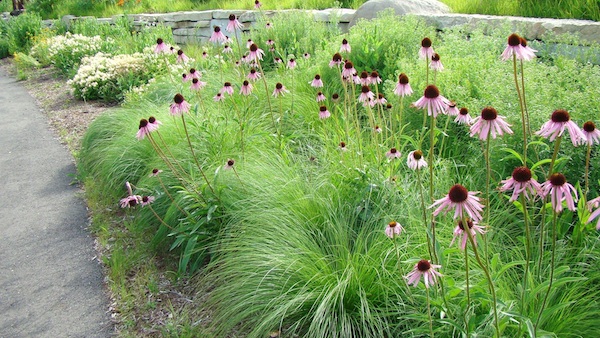Gardening with native grasses in America offers a sustainable and aesthetically pleasing way to enhance landscapes while supporting local ecosystems. Here’s a comprehensive exploration of this gardening approach:
Importance of Native Grasses
Ecological Benefits
Biodiversity Support: Native grasses play a pivotal role in supporting local ecosystems by fostering biodiversity. They serve as essential components of natural habitats, attracting a diverse array of wildlife. Birds, insects, and small mammals are drawn to these grasses, using them for shelter, nesting, and foraging. This sustains the local food web, contributing to a balanced and thriving ecosystem.
Soil Health: One of the most significant contributions of native grasses is their impact on soil health. Their extensive root systems delve deep into the earth, preventing erosion by anchoring the soil. Additionally, these roots help improve soil structure by promoting aeration and microbial activity. This leads to enhanced water retention, reducing runoff and aiding in the absorption of moisture, thereby maintaining healthier soil conditions.
Low Maintenance: Native grasses have evolved over time to adapt to the specific conditions of their regions. As a result, they often require minimal intervention once established. Their resilience to local climates reduces the need for excessive watering, fertilization, and pest control. This characteristic makes them an environmentally friendly choice, contributing to sustainable landscaping practices.
Aesthetic Appeal
Natural Beauty: Native grasses offer a captivating diversity in textures, colors, and heights, enriching landscapes with their inherent beauty. From the fine, airy plumes of grasses like switchgrass to the graceful arching blades of bluestem, each species contributes a unique visual element. Their varied appearances create captivating contrasts and complement other plants, adding depth and character to gardens and natural areas.
Seasonal Interest: Another enchanting aspect of native grasses is their evolving appearance across seasons. Some species showcase vibrant blooms during specific times of the year, while others exhibit striking foliage colors or textures. The changing attributes of native grasses ensure year-round visual interest, contributing to a dynamic and ever-evolving landscape that evolves with the seasons.
Environmental Harmony
Native grasses serve as more than ornamental elements; they are essential components in preserving ecosystems, fostering biodiversity, and enhancing the visual allure of landscapes. Their multifaceted contributions emphasize the interconnectedness between environmental sustainability and aesthetic beauty, promoting a harmonious balance between nature and cultivated spaces.
Cultivating Native Grasses

Selection Process
Research Local Varieties: Begin by researching grass species native to your specific region or climate zone. Local botanical gardens, nurseries, or extension offices often provide valuable information about native grasses thriving in your area. Identifying species adapted to your region ensures their resilience and success in your landscape.
Consider Growth Habit: Understand the growth habits of different native grasses. Factors such as height, spread, and growth patterns (clumping or spreading) influence the overall appearance and suitability for your landscape design. Consider how each grass complements the overall aesthetic and functionality of your garden.
Planting and Care
Site Preparation: Before planting, prepare the site carefully. Assess soil conditions, ensuring proper drainage to prevent waterlogging. Native grasses have diverse sunlight requirements, so choose locations that match their preferences, whether they thrive in full sun, partial shade, or shade.
Planting Techniques: Follow recommended planting guidelines for each species, including planting depths and spacing. Ensure the root system is properly covered without burying the crown. Water newly planted grasses thoroughly to help establish their roots, and maintain a consistent watering schedule until they’ve settled in and are established.
Maintenance
Pruning and Trimming: While native grasses generally require minimal maintenance, some benefit from occasional pruning or cutting back. Trimming back grasses in late winter or early spring helps rejuvenate growth and remove dead foliage, promoting healthier plants.
Seasonal Care: Understanding the seasonal needs of your native grasses is essential. Some species may have specific dormancy periods or seed collection times for propagation. Familiarize yourself with their natural life cycles to provide adequate care and support throughout the year.
Tips for Success
- Soil Testing: Conduct soil tests to ensure the soil pH and nutrients meet the requirements of your chosen grass species.
- Mulching: Consider using organic mulch around the base of young grasses to retain moisture, suppress weeds, and provide insulation.
- Observation and Adaptation: Monitor the growth and health of your native grasses regularly. Adjust care practices based on their response to the environment.
Cultivating Harmony
Cultivating native grasses is a deliberate process that harmonizes with the natural environment. From meticulous selection based on regional adaptability to careful planting and tailored maintenance, nurturing these grasses contributes to sustainable landscaping practices. Cultivating native grasses not only enhances the aesthetics of your landscape but also promotes biodiversity and environmental sustainability.
Design Ideas and Applications
Natural Landscaping
Meadow Gardens: Create picturesque meadow gardens by incorporating a blend of native grass species. The varied heights, textures, and colors of grasses, combined with wildflowers and native plants, emulate a natural meadow setting. This design fosters a relaxed and unstructured ambiance, inviting a sense of tranquility while supporting local biodiversity.
Rain Gardens: Utilize native grasses in rain gardens or bioswales strategically placed to manage stormwater runoff. The deep root systems of these grasses enhance water absorption, reducing soil erosion, and filtering pollutants. This functional and eco-friendly approach to landscaping helps mitigate flooding while promoting sustainable water management practices.
Functional Uses
Erosion Control: Employ native grasses on slopes, embankments, or areas susceptible to erosion. Their robust root systems anchor the soil, preventing erosion and stabilizing steep inclines. This natural erosion control method not only safeguards landscapes but also maintains soil integrity and prevents sedimentation in water bodies.
Wildlife Habitats: Establish grassy areas filled with native grasses to create wildlife-friendly habitats. These spaces attract a diverse range of wildlife, including birds, butterflies, bees, and other beneficial insects. Native grasses provide nesting sites, shelter, and food sources, fostering a harmonious ecosystem and supporting local biodiversity.
Implementing Tips
- Diverse Plantings: Mix various native grass species within these designs to enhance biodiversity and provide a richer habitat for wildlife.
- Site Suitability: Assess the landscape’s conditions—sun exposure, soil type, and moisture levels—to select the most suitable native grasses for each application.
- Maintenance Consideration: Understand the maintenance needs of these landscapes. Some may require occasional mowing or trimming to manage growth and preserve the natural aesthetic.
Environmental Harmony
Designing landscapes with native grasses encompasses both aesthetic appeal and ecological functionality. From creating serene meadow gardens to employing functional solutions like rain gardens and erosion control measures, the incorporation of native grasses not only beautifies spaces but also contributes significantly to environmental sustainability. These design applications showcase the intrinsic harmony between landscaping practices and ecosystem preservation, creating spaces that thrive in tandem with nature’s rhythms.
Tips for Success
Local Expertise
Consulting with local nurseries or landscape professionals well-versed in native grasses specific to your region offers invaluable insights. They can provide guidance on selecting the most suitable species, offer planting recommendations, and advise on maintenance practices tailored to your local climate and soil conditions. Their expertise ensures informed decisions and enhances the success of your landscaping endeavors.
Diverse Plantings
Embrace diversity in your plantings by incorporating a mix of native grass species. By blending various grasses, you not only create visually stunning landscapes but also promote biodiversity. A diverse array of grasses supports a wide range of wildlife, encourages a healthier ecosystem, and adds layers of texture and color to your garden or natural areas.
Adaptation Period
Be patient and allow an adaptation period for native grasses to establish and thrive. These plants might require time to acclimate to their new environment, settle into the soil, and establish robust root systems. It’s common for native grasses to take a growing season or more to reach their full potential. Consistent care and patience during this initial period contribute significantly to their long-term health and vitality.
Additional Suggestions
- Observation and Adjustment: Regularly observe the growth and development of native grasses. Adjust watering, sunlight exposure, or care practices based on their response to the environment.
- Proper Planting Techniques: Follow recommended planting methods, ensuring proper spacing and depth. Adequate soil preparation and initial care greatly impact the establishment of these grasses.
- Learning and Adaptation: Continuously educate yourself about the specific needs and growth patterns of the native grasses you’ve planted. Understanding their natural behavior helps in providing appropriate care and nurturing.
Cultivating Harmony
The success of cultivating native grasses relies on a blend of knowledge, patience, and adaptation. Leveraging local expertise, fostering diversity, and allowing for an adaptation period are key components in nurturing these valuable plants. Through thoughtful practices and a deep understanding of local ecosystems, these tips contribute to the creation of thriving landscapes that support biodiversity, conserve resources, and enhance the natural beauty of your surroundings.
Bottom Line
Gardening with native grasses aligns with sustainable practices and supports local ecosystems while offering a palette of beauty and functionality. By embracing the inherent beauty and ecological benefits of these grasses, gardeners contribute to a harmonious coexistence between landscapes and the environment, creating spaces that thrive in tandem with nature’s rhythms.


